|
Click pictures for a larger version.
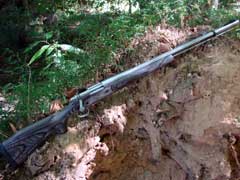
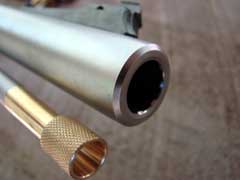
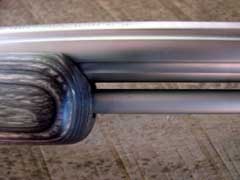
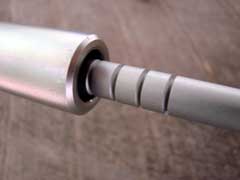
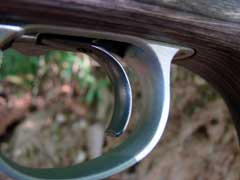
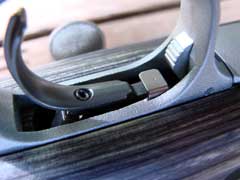
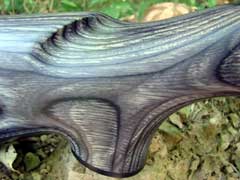
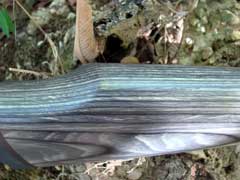
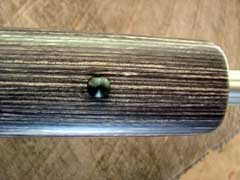
Laminated wood stock.
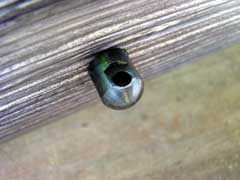

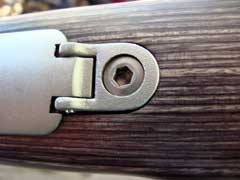

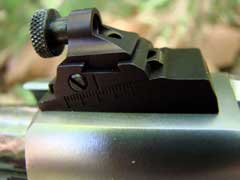

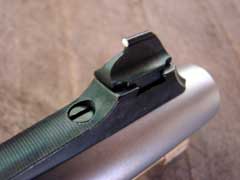
Excellent set of adjustable aperture/bead sights.
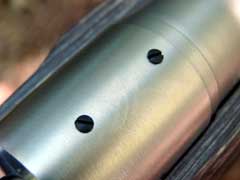
Receiver is drilled and tapped to accept standard
Remington 700 scope bases.

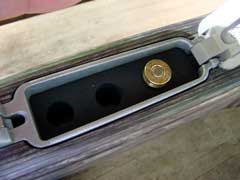
Under floorplate is storage for extra primed cases.
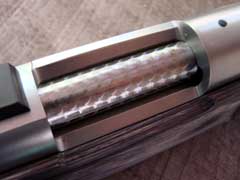
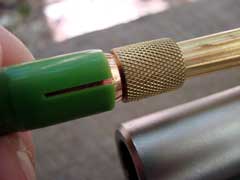
The bullet seater tip on the ramrod fits the AccuTip
bullets perfectly.
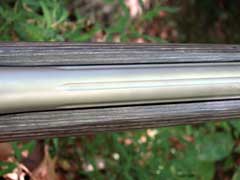
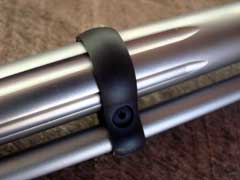
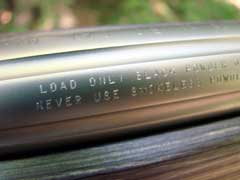
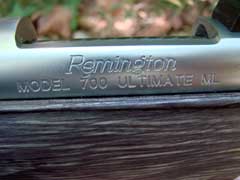
|
|
When I was first introduced to Remington's
Ultimate Muzzleloader system last Spring at the NRA
Show in Indianapolis, I was impressed. I was first impressed
by the simplicity of using a brass cartridge case to hold the
primer and to seal the breech, and was puzzled that no one had
thought of this years before. Muzzle-loading firearms have been
around for well over three hundred years, and brass cartridge
cases have been around for half that time, yet even modern
muzzleloaders have used many different ways of holding the
primer to ignite the powder charge, but I have seen none that
are as simple, reliable, and as easy to use as this U.M.L.
system just introduced by Remington.
Like some other
modern muzzleloaders, the 700 U.M.L. uses a bolt-action
rifle as the basis for the design. However, instead of employing
various breech plug designs that use a shotgun primer to ignite
the charge and seal the breech, the Remington design uses what
amounts to a stretched 45 ACP cartridge case, or shortened
30-06/308 class case that has a primer pocket cut to accept a
large rifle magnum primer. The beauty is that the brass case is
easy to handle, easy to reprime, and relatively inexpensive,
compared to other proprietary primer-holders utilized in other
brands of modern muzzleloading rifles.
The Remington system seals the breech so well
that absolutely no powder gasses escape the sealed breech,
keeping the action perfectly clean, while allowing the rifle to
handle a 200 grain powder charge of black powder, or the
equivalent charge of a black powder substitute, such as
Triple-Seven or Pyrodex.
Like most any muzzleloader, there are
infinite combinations of projectile and powder charges that can
be used, but Remington markets the Ultimate Muzzleloader as a
system, recommending their AccuTip sabot bullet to be used with
pelletized powder charges, and doing so greatly simplifies the
loading of a front-stuffer. Remington claims the ability to push
their 250 grain bullet to 2400 feet-per-second (fps), using
pelletized black powder substitute.
The Model 700 U.M.L. is built primarily of
stainless steel, using the proven Model 700 bolt action, mated
to a twenty-six inch fluted stainless fifty-caliber barrel. The
barrel has a one-in-twenty-six-inch (1:26) right-hand rifling
twist. The rifle is available in two versions, with the one
shown here wearing a laminated wood stock, and having a very
good set of mechanical sights. The other version has no sights,
and wears a synthetic stock. The trigger is very crisp,
reliable, and user-adjustable. The sample rifle shown here has a
trigger which released with right at four pounds of resistance.
In addition to the adjustable aperture sight, the receiver is
drilled and tapped to accept standard Model 700 scope bases. The
rifle has a very sturdy stainless steel ramrod, with a brass
bullet-seating tip that is shaped to load the AccuTip bullet
without damage to the polymer tip. The AccuTip bullet is a
homogenous copper hollowpoint, which I presume is made for
Remington by Barnes Bullets, as it is their same excellent
design, and Barnes and Remington are owned by the same parent
company. The rifle shown here with the laminated stock weighed
in at eight and three-quarters pounds. Under the floorplate is
storage for three of the primed cases, to keep handy for a quick
reload. With any muzzleloader, "quick" is a relative
term when it comes to reloading the rifle, but the pelletized
powder and primed brass cases make handling the components
easier, and thus faster, than measuring loose powder and
fumbling with shotgun primers or percussion caps. The saboted
bullets are tight, and a bit hard to start down the bore, but
once started, they slide smoothly down to the powder charge.
I tested the Model 700 U.M.L. for velocity
and accuracy, in addition to observing its handling qualities
regarding the operation of a muzzleloading rifle. I checked
velocities at a distance of ten feet from the muzzle, using both
Pyrodex and Triple-Seven pellets. While I checked velocities
with charges from one to four pellets, most of my shooting was
done with a full four-pellet charge, as the weapon is advertised
to be a 300 yard muzzleloader, with power to take large game,
and for that, maximum charges are preferred. The chart below
shows the trajectory of the 250 grain AccuTip bullet out to 300
yards, using the actual velocity of 2350 fps achieved at ten
feet from the muzzle, using a four-pellet (fifty grains each)
charge of Triple-Seven propellant. Velocities were recorded at
an elevation of approximately 541 feet above sea level, with
temperatures hovering around the seventy-two degree Fahrenheit
mark, with a relative humidity of thirty-six percent.
Calculated Table
|
|
Range
|
Drop
|
Drop
|
Windage
|
Windage
|
Velocity
|
Mach
|
Energy
|
Time
|
Lead
|
Lead
|
|
(yd)
|
(in)
|
(MOA)
|
(in)
|
(MOA)
|
(ft/s)
|
(none)
|
(ft•lbs)
|
(s)
|
(in)
|
(MOA)
|
| 0
|
-1.5
|
***
|
0.0
|
***
|
2363.5
|
2.117
|
3100.4
|
0.000
|
0.0
|
***
|
| 25
|
-0.0
|
-0.2
|
0.1
|
0.5
|
2263.4
|
2.027
|
2843.3
|
0.032
|
5.7
|
21.8
|
| 50
|
1.0
|
1.9
|
0.5
|
1.0
|
2165.6
|
1.940
|
2603.0
|
0.066
|
11.7
|
22.3
|
| 75
|
1.5
|
2.0
|
1.1
|
1.5
|
2070.3
|
1.854
|
2378.9
|
0.102
|
17.9
|
22.8
|
| 100
|
1.6
|
1.5
|
2.1
|
2.0
|
1977.4
|
1.771
|
2170.2
|
0.139
|
24.4
|
23.3
|
| 125
|
1.1
|
0.8
|
3.3
|
2.5
|
1887.1
|
1.690
|
1976.6
|
0.178
|
31.3
|
23.9
|
| 150
|
-0.0
|
-0.0
|
4.9
|
3.1
|
1799.6
|
1.612
|
1797.4
|
0.218
|
38.4
|
24.5
|
| 175
|
-1.8
|
-1.0
|
6.8
|
3.7
|
1714.9
|
1.536
|
1632.3
|
0.261
|
45.9
|
25.1
|
| 200
|
-4.3
|
-2.1
|
9.1
|
4.4
|
1633.4
|
1.463
|
1480.8
|
0.306
|
53.8
|
25.7
|
| 225
|
-7.6
|
-3.2
|
11.8
|
5.0
|
1555.3
|
1.393
|
1342.6
|
0.353
|
62.1
|
26.4
|
| 250
|
-11.9
|
-4.5
|
15.0
|
5.7
|
1480.9
|
1.326
|
1217.1
|
0.402
|
70.8
|
27.0
|
| 275
|
-17.1
|
-5.9
|
18.5
|
6.4
|
1410.4
|
1.263
|
1104.1
|
0.454
|
79.9
|
27.8
|
| 300
|
-23.4
|
-7.4
|
22.5
|
7.2
|
1344.4
|
1.204
|
1003.1
|
0.509
|
89.5
|
28.5
|
As shown in the chart, with a 150 yard zero,
the trajectory shows the bullet is about a foot low at 250
yards, and almost two feet low at 300. One could flatten the
trajectory relative to line of sight by setting the zero at 200,
but I think that for most hunting situations, the 150 yard zero
is a better choice, as it keeps the bullet's path to within
about four inches of the line of sight out to 200 yards.
For accuracy testing, I mounted a Trijicon
5 to 20 power AccuPoint scope atop the Model 700 using
Trijicon bases and rings. This scope has excellent clarity, as
well as generous eye relief, allowing for accurate and
comfortable shooting from the bench. Most accuracy testing was
done with maximum charges of Pyrodex and Triple-Seven, with the
former turning in a slightly better accuracy performance. Both
powders shot a bit more accurately using a three-pellet load,
but again, this rifle is built and promoted to use maximum loads
approaching the power of hot-loaded 45-70 Magnum-class
ammunition, and therefore that is the load which I fired for
accuracy testing at one-hundred yards, with both types of powder
exhibiting good accuracy for hunting at that distance, with the
Pyrodex load having the accuracy needed to take game much
farther out. The rifle was comfortable to shoot, both standing
and from the bench, even with full 200 grain powder charges.
I was very impressed by the cleanliness of
this rifle. Even after extended firing sessions exceeding fifty
rounds per session, the action remained just as clean as when
the rifle was unpacked from the box upon arrival. The brass
cases were also perfectly void of any powder residue after
firing, both inside and out, proving that the cases were totally
sealing the breech upon firing. Likewise, the barrel was easy to
keep clean inside. I ran a wet patch down the bore about every
ten shots, followed by a dry patch, and the lack of powder
residue indicated the most-complete burn of any muzzleloader
that I have ever fired, including the smokeless muzzleloader
built by Savage a few years ago. The powder residue in the bore
was not the reason for the periodic cleaning, but the plastic
residue left by the sabot made loading a bit harder after a few
firings, but the Remington MZL Bore Cleaner easily removed both
the plastic and powder fouling.
With the Model 700 U.M.L., Remington has
built what is arguably the best modern muzzleloading rifle to
date. It is powerful, accurate, easy-to-load, and one hundred
percent reliable. As of the date of this review, the suggested
retail price of the Model 700 U.M.L. shown here is $949 US,
which is not cheap, and you can pay a lot less for a
muzzleloading rifle, but you never regret buying the best.
Check
out the extensive line of Remington firearms, ammunition, and
accessories online at www.remington.com
Jeff Quinn
  
Got something to say about this article?
Want to agree (or disagree) with it? Click the following link to
go to the GUNBlast Feedback Page.
|
|
Click pictures for a larger version.
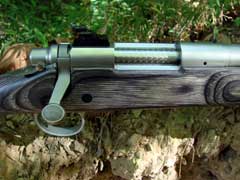
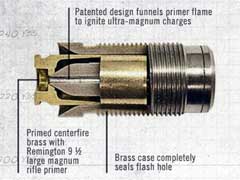
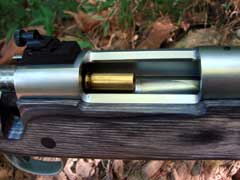
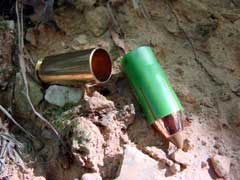
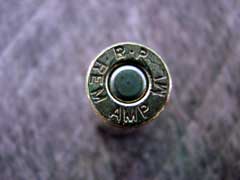
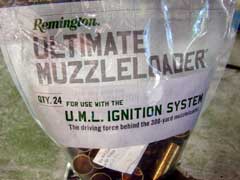

UML system uses primed brass cases for ignition.


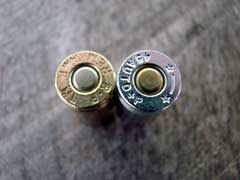
Brass case used for ignition is basically a stretched
45 ACP case cut for a large rifle primer, or a shortened
308/30-06 class rifle case.
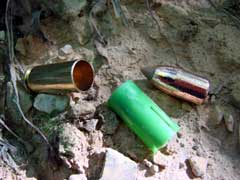
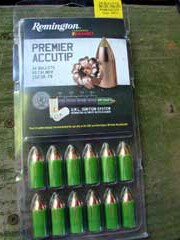

250-grain AccuTip bullet/sabot.
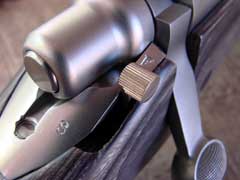
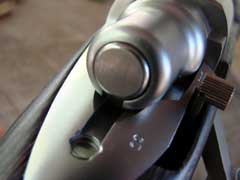


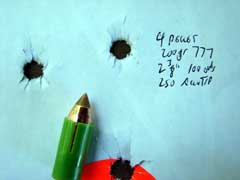
With maximum loads, Pyrodex proved to be more
accurate than 777 with the 250-grain AccuTip, in this
particular rifle.

Remington Cleaner dissolves powder and sabot fouling. Lubed patches
prevent corrosion.
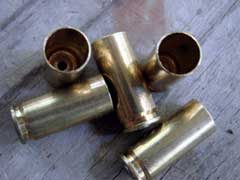
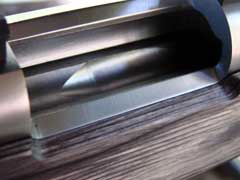
The breech and cases remained clean after over 50
firings, proving that the brass case seals the breech
perfectly.
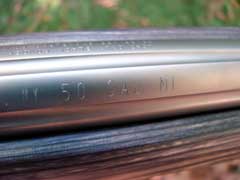
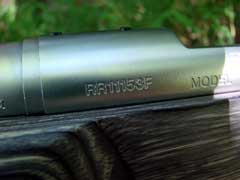
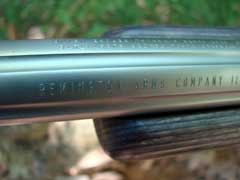
|
![]()